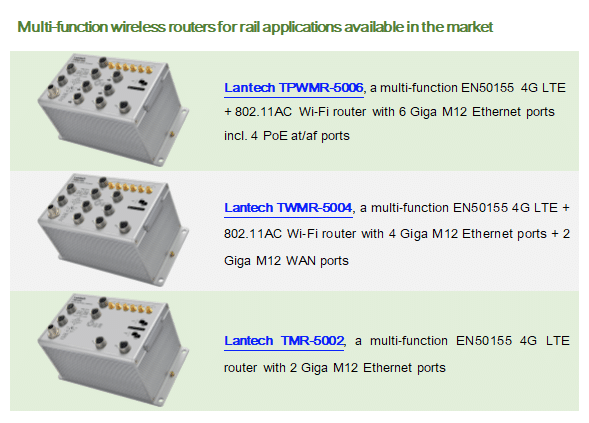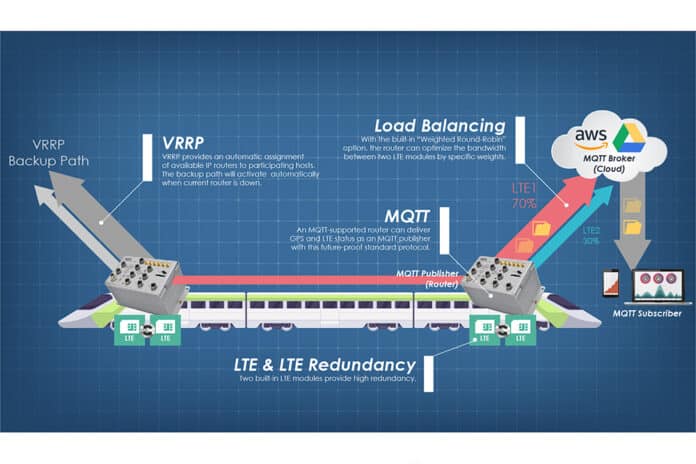Wireless routers are widely adopted in rail applications, including on-board communications and trackside/train-to-ground networks. They transmit data without any obstruction for moving rolling stocks and also provide redundant connection for wired /Fiber backbone networks.
Lantech has listed 10 important things to consider when purchasing a wireless router for these applications.
1. Is it compliant to rail-related standards?
Rail-related applications are complicated and critical. A simple problem may result in a disaster which can cause injuries or even loss of lives. Thus, several standards for the rail industry are established, such as EN 50155, EN 50121, and EN 45545. These standards provide guidelines that ensure higher reliability, less radio interferences, and the highest level of safety possible in the event of a fire. Never consider a router without checking for compliance of these standards.
2. Is it a multi-function wireless router?
Currently, multi-function routers are very popular due to their space saving features and cost effectiveness. More and more functions are being integrated into compact wireless routers. For example, Lantech has launched a series of 7-in-1 EN50155 routers in to the market, which include Wi-Fi, LTE, Storage, PoE, Gateway, VPN, and Managed Switch. Reducing the number of devices within a network also reduces the operational & maintenance requirements.
3. Does it provide redundancy for mobile connectivity?
A router with two built-in 4G LTE modules (up to 4 sim card slots) provides further protection and a fast recovery time to the network compared to a router with only one 4G LTE module. It also allows the possibility to choose different 4G service providers in order to reduce risk when a provider is down ensuring the continuation of the service.
4. VRRP-support provides further redundancy for connectivity
The Virtual Router Redundancy Protocol (VRRP) is a computer networking protocol that provides an automatic assignment of available IP routers to participating hosts. This increases the availability and reliability of routing paths via automatic default gateway selections on an IP sub-network. Choosing a router with VRRP ensures the network will have further redundancy.
5. In the IoT era, it should support MQTT protocol
MQTT is a standard messaging protocol for the Internet of Things (IoT). It is designed as an extremely lightweight publish/subscribe messaging transport that is ideal for connecting remote devices with a small code footprint and minimal network bandwidth. An MQTT-supported router can deliver the GPS and LTE status as an MQTT publisher with this future-proof standard protocol.
6. Can it optimise your network bandwidth?
With limited bandwidth, the best way to manage bandwidth has become a major concern. Adopting a wireless router with built-in “Load Balancing” technology provides a way to optimise LTE/WAN connections according to the application.
7. Security, security, security
Increased network attacks have become a critical issue as well, rail applications are not excepting. Security is critically important in rail applications in order to prevent any trains or metro networks from being hacked and to prevent any anonymous person to take control of a mass transportation system. A firewall is also essential and the VPN helps support this by creating an isolated and secure connection.
8. Input voltage and isolation protection are important
Rail applications cover rolling stock vehicles and stations services and may come with different power supply voltages. An ideal wireless router for rail should be able to work on a vehicle with a 24/72/110VDC power input and should also be able to boost or step-down the voltage to 48VDC to feed power to PoE devices such as IP cameras and IP phones. However, just being able to boost/step-down the voltage to the required level is not enough, the router/switch also needs to provide an isolated power design in order to avoid damages due to the unstable power supply from the train system, especially when starting the rolling stock.
9. Does it support Wireless Roaming and MESH?
The support of wireless roaming and MESH can build a stable and reliable wireless network for moving rolling stocks. The trains can stay online for constant monitoring and provide higher service quality.
10. Which wireless standard does it support?
Some products are still using the old IEEE 802.11n Wi-Fi standard, however the newer IEEE 802.11ac standard provides faster and cleaner wireless thanks to its dual band ability. The 802.11ac standard has been around for several years already and is well established for industrial applications.








































 0113 2082620
0113 2082620 info@railbusinessdaily.com
info@railbusinessdaily.com 15 Mariner Court, Wakefield WF4 3FL
15 Mariner Court, Wakefield WF4 3FL

